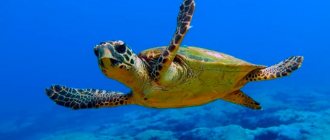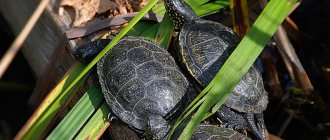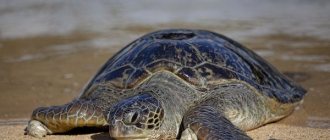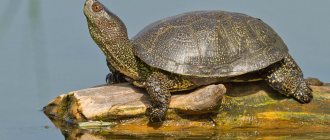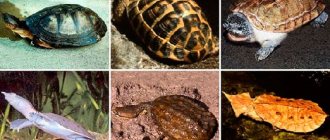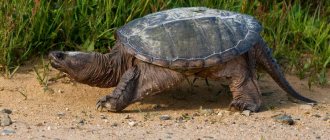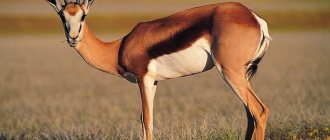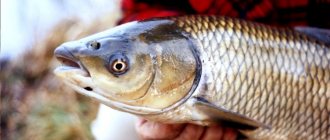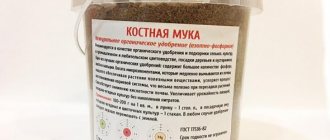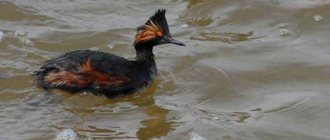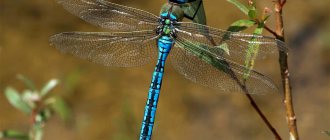Review author: “ZooVita”
Among all reptiles, the leatherback turtle is of particular interest. The reason for this was the structural features of the shell, which does not have the usual horny plates.
In addition, an adult can reach more than 2 meters in length and 400 kg of body weight. Photos of the leatherback turtle can be found on the pages of encyclopedic collections.
WHAT DOES IT EAT?
Thanks to its front flippers—appropriately modified forelimbs—the leatherback turtle can easily cover long distances, but it is still too slow to hunt fish and agile cuttlefish.
The object of her hunting are slower jellyfish and other animals that swim with plankton at the surface of the water or in its thickness. Jellyfish can be enormous in size, but they consist primarily of water and have little nutritional value compared to fish. Therefore, in order to get enough, the turtle eats jellyfish in huge quantities.
The leatherback turtle is insensitive to jellyfish venom, which is released by hundreds of stinging cells and can paralyze and kill fairly large fish. However, the leatherback turtle deliberately avoids encounters with representatives of particularly poisonous species.
Nutrition
The main and favorite food of these mammals are jellyfish of various sizes. The mouth of leatherback turtles is designed in such a way that once a victim gets inside, it is simply unable to get out.
Many times fish and crustaceans were found in the stomach of turtles. But, according to scientists, to a large extent they get there purely by chance along with jellyfish. In search of food, these reptiles can cover enormous distances.
CHARACTERISTICS
The leatherback turtle, at first glance, lacks a characteristic feature of its order - a powerful shell made of horny plates. The shell of most turtles consists of two parts: dorsal and abdominal shields, which in turn consist of horny scutes, which are covered from the inside with durable bone plates. The shields are connected to the spine and ribs, forming a very strong structure in which only the head, limbs and tail retain mobility. Fossils found indicate that the ancestors of modern turtles had bodies designed almost identically to those of the leatherback turtle. The biggest change in the evolution of sea turtles was the reduction of the shell, which previously covered the entire body. The horny plates were gradually replaced by tough skin, and the internal bone plates turned into small, interconnected bones. This is how the turtle formed a light shell. The leatherback turtle has few natural enemies - it is too large to become prey, so it does not need the hard shell of a land turtle. People consume leatherback turtle meat, although there have been rare cases of poisoning.
Natural enemies
Possessing a solid mass and an impenetrable carapace, the loot has practically no enemies on land and in the sea (it is known that an adult reptile is not afraid even of a shark). The turtle escapes from other predators by deep dives, descending 1 km or more. If it fails to escape, it confronts the opponent, fighting back with strong front legs. If necessary, the turtle bites painfully, using jaws with sharp horny serrations - the enraged reptile quickly bites through a thick stick.
In recent years, humans have become the worst enemy of adult leatherback turtles . He is responsible for the pollution of the oceans, illegal trapping of animals and insatiable tourist interest (loot is often attacked by plastic waste, mistaking it for food). All factors combined have significantly reduced the number of sea turtles. The turtle offspring have many more ill-wishers. Small and defenseless turtles are eaten by carnivorous animals and birds, and predatory fish lie in wait in the sea.
Return to content
REPRODUCTION
The leatherback turtle is a typical marine animal, but it comes to land to breed. Until recently, the locations of the eggs of this turtle were unknown to scientists. Today, only a few tropical beaches are known where female leatherback turtles lay eggs. Turtles appear to prefer cliffs, deep waters, and avoid coral reefs. Even a strong surf will not stop them on the way to their goal. Sea turtles mate at sea, after which the female comes to land to lay eggs. She does this at night, during high tide. Slowly moving along the beach, she looks for wet places in the sand that the waves do not reach. The female probes the soil, chooses the best place and digs a hole with the help of her front and hind limbs. Having dug a sufficiently large hole, the female lays from 30 to 130 eggs, which she transfers into the hole with her hind fins. Having laid the clutch, the female buries a hole and returns to the sea. It thoroughly compacts the sand, so the masonry is practically inaccessible to predators. During one season, the female makes 3-4 clutches. After two months, small turtles are born from the eggs and run straight into the sea. Many of them become prey for seagulls and other predators on their way to water. The surviving females return to their native places after many years to, in turn, also lay eggs.
Lifestyle
Adults are found mainly in the open ocean. These animals are tireless travelers. There are known cases of overcoming a huge distance of 20,000 km. from the USA to Indonesia. The leatherback turtle's tracked journey took 647 days, during which it fed primarily on jellyfish. During the day, the reptile preferred deep waters, and surface waters at night. This strategy allowed the turtle to constantly stay in the layer of water where most of the jellyfish are located, making daily migrations upward in the dark and descending during the day.
It is jellyfish that constitute the main diet of adult reptiles, although they can also prey on other soft-bodied animals - cephalopods and tunicates.
It's scary that trash thrown into the ocean can literally kill a leatherback turtle. She perceives a plastic bag floating in the water as a jellyfish. It is clear that eating garbage will not bring anything good to the animal. It is estimated that one in three turtles eat plastic. Given the limited population of animals, it is scary to imagine the amount of garbage in the world's oceans.
Like all sea turtles, the leatherback begins its life journey by crawling out of the sand of the beach where its mother laid her egg. These first minutes of life are the most dangerous. On the way to the water, young turtles are waited by birds, other reptiles, and some mammals. Those few who were able to get to the saving water have a better chance of survival than those who hesitated on the shore.
ADAPTATION FEATURES OF THE LEAFIN SEA TURTLE
The leatherback turtle is a cold-blooded animal whose body temperature depends on the temperature of the environment, in this case sea water. The turtle is protected from the influence of fluctuations in water temperature by a thick layer of subcutaneous fat, an excellent insulating material, as well as a developed network of vessels in the forelimbs, where rapid blood circulation occurs. Vessels with warm arterial and cold venous blood intertwine near the surface of the limbs, while the warm blood gives up some of the energy to the cold and returns back. This adaptation, as well as its large size, allows the turtle to be in water with a temperature of 12°C.
View status today
A significant decline in the leatherback turtle population, which has now reached 97%, led to the creation of a project to protect the reptiles. The joint activities of a number of countries led to the assignment of international status to the project.
On the coasts of countries with tropical and subtropical climates, protected areas are created where animals can freely organize their clutches. Protecting the environment from pollution and the consequences of human activities is of great importance. The leatherback turtle population must be controlled.
However, it is often not possible to track the migration of representatives, because reptiles are extremely alert, and in case of danger they dive to great depths.
GENERAL PROVISIONS. DESCRIPTION
To increase the number of turtles, their eggs are collected, then they are artificially incubated and the turtles are released into the sea.
This is the largest living turtle. Reaches a length of 2 m, weighs 600 kg. It nests on the tropical coasts of the Indian, Pacific and Atlantic oceans. Returns to the same nesting site every 2-3 years. Travels, feeds in temperate waters on jellyfish, algae, and crustaceans. The shell of a turtle consists of longitudinal bony ridges, between which skin is stretched, which in its density and elasticity resembles rubber. The leatherback turtle lays an average of 85 eggs measuring 5-6 cm on land, where it itself was once born.
Habitat
The habitat extends throughout the subtropical and tropical regions of the world's oceans. Since the reptile can maintain a body temperature higher than the temperature of the surrounding water, it is also found in temperate latitudes, up to Alaska and Norway.
There are three genetically distinct populations of the leatherback turtle: Atlantic , Pacific and Indian .
The Atlantic leatherback turtle feeds primarily on jellyfish, which are widespread in the cold waters of the Atlantic. The reptile, like large mammals, grazes in feeding fields. Only a few beaches are suitable for breeding. The most significant breeding sites are in the Caribbean, Gabon and French Guiana. It is in Gabon that there are beaches favored by leatherback turtles. Every year in April, about 30 thousand reptiles visit them.
The Pacific leatherback turtle is divided into two groups. One inhabits the coasts of Papua, Solomon Islands, Indonesia and North America. The second group is found off the coast of South America, Mexico and Costa Rica.
The Indian population has been studied relatively poorly. Known habitats are near Sri Lanka and the Nibor Islands.
INTERESTING FACTS
- Leatherback sea turtles travel throughout all the seas of the world. These animals, seen in Suriname, were soon observed in another part of the ocean, 6,800 km from Suriname.
- The leatherback turtle is found in all seas of the world - from Iceland in the north to New Zealand in the south.
- Through observations, it was established that leatherback turtles lay eggs once every few years, but in large quantities, making up to 3-4 clutches of 30-130 or more eggs.
- The leatherback turtle is a typical inhabitant of the open sea. She is not kept in captivity because it is impossible to create conditions for her. The leatherback turtle requires a huge amount of water space.
Head
The turtle's head is oval-shaped with small dimensions, thanks to which it can quickly hide it in a “bunker” in case of danger. Also in nature there are reptiles whose heads do not fit into the “protective capsule”.
Note!
- Euthanasia of animals.
- Spitz. Features of the breed.
Car hammock for dogs. What it is?
Due to the peculiarities of the turtle's lifestyle, its eyes are positioned so that they can look under its paws. In marine reptiles, on the contrary, they are located higher and directed into the distance.
CHARACTERISTIC FEATURES OF THE Leatherback Turtle
The massive carapace tapers towards the rear end of the body. Unlike the shell of other turtles, it is not covered with horny plates, but with thick, tough skin, on which there are bone plates in a mosaic pattern.
Forelegs:
very strong, in the form of fins, pointed at the ends. The span of the limbs reaches 3 m. The fins are used for swimming, digging holes for eggs, and sometimes for self-defense.
There are 7 movable ribbed stripes on the upper side of the shell, and 5 on the lower side.
— Habitat of the leatherback turtle
WHERE DOES IT LIVE?
The habitat of the leatherback turtle is very large. It lives in all oceans except the polar regions.
PROTECTION AND PRESERVATION
Leatherback turtles that lay eggs in traditional areas are at risk of being harmed by turtle egg collectors. The development of the tourism business has a negative impact on the life of turtles. The leatherback turtle is a protected species.
Freshwater relative
Another soft-bodied one deserves attention - Chinese Trionix. It is found in the wild in the Far East, Japan, Korea, and China.
The turtle grows up to 25-40 cm. From birth to death, there are no horny plates on the body. Their place is taken by the elastic carapace. The muzzle ends in a funny trunk with nostrils. Color varies from olive to dark green.
Lovers of domestic animals breed trionics in terrariums. Recommended container volume from 60 l. For comfort, housing must be equipped with a sandbank, a filter, and a heating element.
Consider your pet's aggressiveness. He does not intend to share the territory with the fish, and attempts to pick him up may result in a painful bite.
THE BIGGEST TURTLE CAUGHT IN THE AMAZON. Video (00:01:32)
The world's largest turtle was found in the Amazon River. Its age is about 529 years, its weight is 915.87 kg... The leatherback turtle (lat. Dermochelys coriacea) is the only modern species from the family of leatherback turtles (Dermochelyidae). These are the largest modern turtles: body length reaches 2.5 meters, weight 600 kg, front flipper span 5 m. Since the Triassic, the evolution of these animals has followed a separate path, so they differ significantly from other turtles. Their shell is not connected to the skeleton and consists of small bone plates connected to each other, the largest of which form longitudinal ridges. There are no horny scutes; the carapace is covered with dense skin, possibly formed by fused horny scutes. The average density of the body is approximately the same as the density of sea water.
Anatomical and physiological structure
The leatherback turtle received laurels not only as the largest in its order, it is also the fastest reptile. Researchers have recorded that adult individuals can easily reach speeds of up to 35 km/h. As for the overall dimensions, the record recorded weight of such a turtle was 916 kg with a body length of 3 meters. A unique specimen was discovered off the west coast of Wales. The average parameters of adult turtles are about 700 kg with a length of 2.7 meters.
And one of the largest land reptiles is the snapping turtle.
The teardrop-shaped body structure allows the leatherback turtle to feel more confident in the waters of the open ocean. The span of the front flippers in some cases can reach 5 m, and their size is considered the largest among all reptiles. There are 7 ridges on the reptile's shell, running from its upper part and reaching the rear area. The upper part of the body is painted in dark gray and black tones, on which light spots sometimes appear.
The leatherback turtle does not have much of the beta keratin found in other reptile species. This type of protein is responsible for mechanical strength, second only to chitin in this indicator. The animal does not need teeth at all - instead, there are bony points on the front beak that perform similar functions. Behind the growths there are also spines, which facilitate the process of swallowing food.
Ocellated trionix
Quite large turtles - up to 60 cm in length. Young ocellated trionics have spots on their shells that resemble eyes—it is from these that the turtles got their name.
You can meet these beautiful turtles in eastern India and Bangladesh. If you are the owner of a very spacious aquarium, you can buy such a reptile - of course, such a pleasure will cost you a lot, but it will be great to impress your guests. Ocellated trionics feed on fish and newborn mice.
Keeping at home
For a turtle to live comfortably in a city apartment, it is important to create conditions close to its natural habitat. This is not difficult to do, but there are several features and requirements for the equipment of the turtle’s future habitat.
Equipment for the turtle's habitat
- Terrarium or aquarium . The size depends on the type of turtle. With its size of 12 cm, the minimum dimensions of the terrarium are 60x40x40 cm. It is better to choose a place of detention that is 5 - 6 times larger than the size of the turtle. If there are cats or dogs in the house, you need to choose a terrarium with a top lid.
- Ultraviolet lamp . Provides vitamin D, which affects calcium absorption. The deficiency of which leads to brittle bones and softening of the shell.
- Incandescent lamp . Necessary for lighting and heating. When installed in a terrarium, there should be warmer areas with a temperature of +30-35°C, and less heated areas with a temperature of +24-27°C.
- Thermometer . Used to control temperature conditions. For safety reasons, it is better to purchase alcohol devices.
- Soil (bottom covering) . The best options would be large pebbles or gravel; you can use a special substrate, hay or sawdust. It is undesirable to use sand, as the turtle may swallow it, which will lead to illness in the animal.
- House . Under natural conditions, turtles make their own shelters. In the terrarium they are replaced by a house. It is better if it is made of easily washable materials: ceramics, durable plastic. It should be located on the opposite side of the heating lamp.
- Feeder . Small in volume, stable container. It is not recommended to place it under a lamp.
- Drinking bowl . The preferred option is a low, large, heavy container. The greater weight will prevent the drinker from tipping over, and the low height of the sides will allow the turtle to reach the water without effort.
Features of care and maintenance
- Nutrition . The turtle should be fed once a day; adults are allowed every other day. In the turtle’s diet, greens (salads, sorrel, dandelions, clover, other grass) should make up 70-80%, fruits, vegetables and berries (strawberries, apples, apricots, watermelon, zucchini, cucumbers, bell peppers) 20-30%, periodically Vitamins and calcium must be added to food.
- UV irradiation . To maintain health, turtles need to turn on the UV lamp for at least 3-4 hours. The most optimal mode would be to operate the lamp during daylight hours.
- Temperature regime . The optimal temperature in the terrarium should vary from +21 to +35°C. If at night the temperature drops below +20°C, it is necessary to additionally equip the terrarium with an infrared lamp.
- Bathing . When kept at home, land turtles need to be bathed, and they really enjoy this procedure. It is carried out at least once a week. The water temperature should be +25-30°C. The water level should not exceed half the height of the shell. The bathing time is no more than 30 minutes, after which the turtle needs to be wiped dry with a towel and placed under a lamp.
- Care of claws and beak . Turtles should have their claws shortened if they cannot be sharpened at home. This is done using a file, scissors or nippers. The growths on the beak are not cut off, but broken off in small pieces. To avoid injury to the turtle, these operations are best performed in a veterinary clinic.
- Cleaning . The feeder and drinker are washed daily. The aquarium filler, if it cannot be washed (sawdust), is changed as it becomes dirty - 1-2 times a week. The house, large stones, and the terrarium itself are washed once a week.
